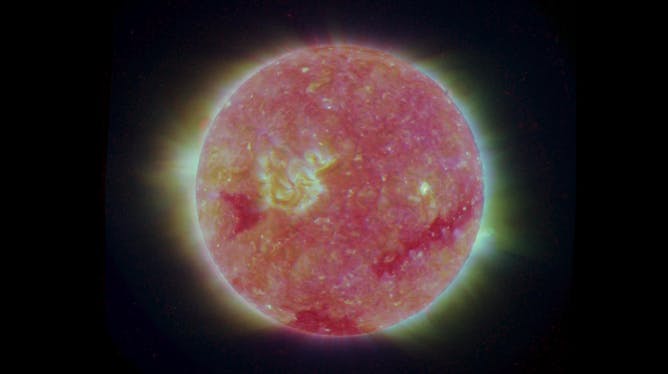|
|
|
|
It’s almost here! The moment we’ve been waiting for — especially if you’re into astronomy, spectacular cosmic events and editing scientific articles. Today a total solar eclipse will grace the skies along a narrow path that moves through parts of eastern Canada, the United States and Mexico.
Here at The Conversation Canada, we began to anticipate the hype a year ago, when we published this article by Langis Michaud at Université de Montréal about how to prepare for this eclipse.
More recently, we’ve published articles by authors from various disciplines — including astronomy, astrophysics, classics, art history, visual culture and emergency management — as they considered the eclipse from different angles.
Daryn Lehoux from Queen’s University writes about how and why eclipses occupy a particular space in the human imagination. Solar eclipses were once believed to prophecy the death of kings, and this unfortunate association directly contributed to the birth of astronomy as ancient cultures developed tools to predict them.
Archeoastronomy uses written descriptions of eclipses in ancient texts to measure time and figure out when a historical event happened.
When it comes to actually witnessing the event, safety first! Using eye protection is important. Capturing the event on camera also requires some preparation and, hopefully, satellites won’t ruin the moment.
In anticipation of the eclipse, the Niagara region, expecting an influx of a million eclipse tourists, has announced a pre-emptive state of emergency — Jack Rozdilsky of York University describes the decision as a prudent move to help keep the crowds safe.
Studying eclipses has contributed to scientific knowledge beyond astronomy. Martin Connors of Athabasca University describes how solar eclipses can bend light, a discovery that proved Albert Einstein’s theory of gravity. Connors also writes about the unique opportunity that a total eclipse provides to see the “strange whitish light” that is the sun’s corona.
Here’s hoping it’s not too cloudy in parts of eastern Canada today, and that the collective experience of a once-in-a-lifetime cosmic spectacle will be a transformative event.
Also today:
All the best — and happy Eclipse Day if you're in eastern Canada!
|

|
Nehal El-Hadi
Science + Technology Editor
|
|

The Cosmic Cliffs region of the universe is considered to be a hotbed of new star formation.
(NASA/James Webb Space Telescope)
Hanika Rizo, Carleton University
Analysis of fragments of the first solids that emerged out of the birth of the sun date our supernova as being 4.6 billion years old.
|

Detail from a stone slab showing the Mesopotamian king Barrekub praying.
(Osama Shukir Muhammed Amin/Wikimedia Commons)
Daryn Lehoux, Queen's University, Ontario
To protect their kings, ancient Mesopotamians discovered how to predict eclipses, which were associated with the deaths of rulers. This eventually led to the birth of astronomy.
|

Anti-carbon tax protesters wave signs and chant slogans as they block a westbound lane of the Trans Canada Highway near Cochrane, Alta., April 1, 2024.
THE CANADIAN PRESS/Jeff McIntosh
Ekaterina Rhodes, University of Victoria
Why the public resistance to carbon tax policies? New research suggests a few key factors that may play a role in influencing popular support for carbon tax efforts in Canada.
|

Lake Koocanusa is seen in June 2021, northeast of Libby, Mont. Mining and other environmental pollutants present serious risks to North America’s fresh water.
(Hunter D'Antuono/Flathead Beacon via AP)
Ben R. Collison, Dalhousie University
Fining companies that flout environmental regulations is an effective strategy, if the penalties are severe enough.
|

Both the Canadian Paediatric Society and the American Academy of Pediatrics recommend opioids be considered for short-term pain if acetaminophen and ibuprofen are inadequate.
(Shutterstock)
Samina Ali, University of Alberta
No parent wants to see their child suffer and untreated pain can have health consequences. But parents may have concerns about use of opioids for their child’s acute pain. Here are tips for safer use.
|

Many older immigrants seeking information across various media types are often driven by the wish to support their communities.
(Shutterstock)
Natalia Balyasnikova, York University, Canada; Claire Ahn, Queen's University, Ontario
Contrary to assumptions that seniors are technologically averse, many older adults now show remarkable agility in navigating digital media.
|
La Conversation Canada
|

La couronne solaire est bien visible sur cette image prise en 2007.
(NASA/JPL-Caltech/NRL/GSFC)
Martin Connors, Athabasca University
La couronne solaire sera visible lors de l’éclipse solaire du 8 avril. Les astronomes tentent encore de percer les mystères de cette couronne, notamment de comprendre pourquoi elle est si chaude.
|
Arts
|
-
Sarah Lonsdale, City, University of London
An expert in journalists in fiction and film reviews Gillian Anderson’s portrayal of Emily Maitlis.
|
|
Politics
|
-
Sarah Schiffling, Hanken School of Economics; Foteini Stavropoulou, Liverpool John Moores University
Humanitarian workers are protected by international law, but the number of aid agency workers being killed around the world is growing.
-
Jordan Tama, American University School of International Service
Israel has historically made statements and taken actions to placate US anger without always following through. But will Biden’s threat to put conditions on aid force Israel to behave differently?
|
|
Science + Tech
|
-
Michael Mulvihill, Teesside University
The Starfish Prime test in 1962 showed how dangerous it would be to detonate a nuclear weapon in space.
|
|
|
|
| |
| |
| |

|
| |
| |
| |
| |
| |
| |
|
|
|
|
|
|
|